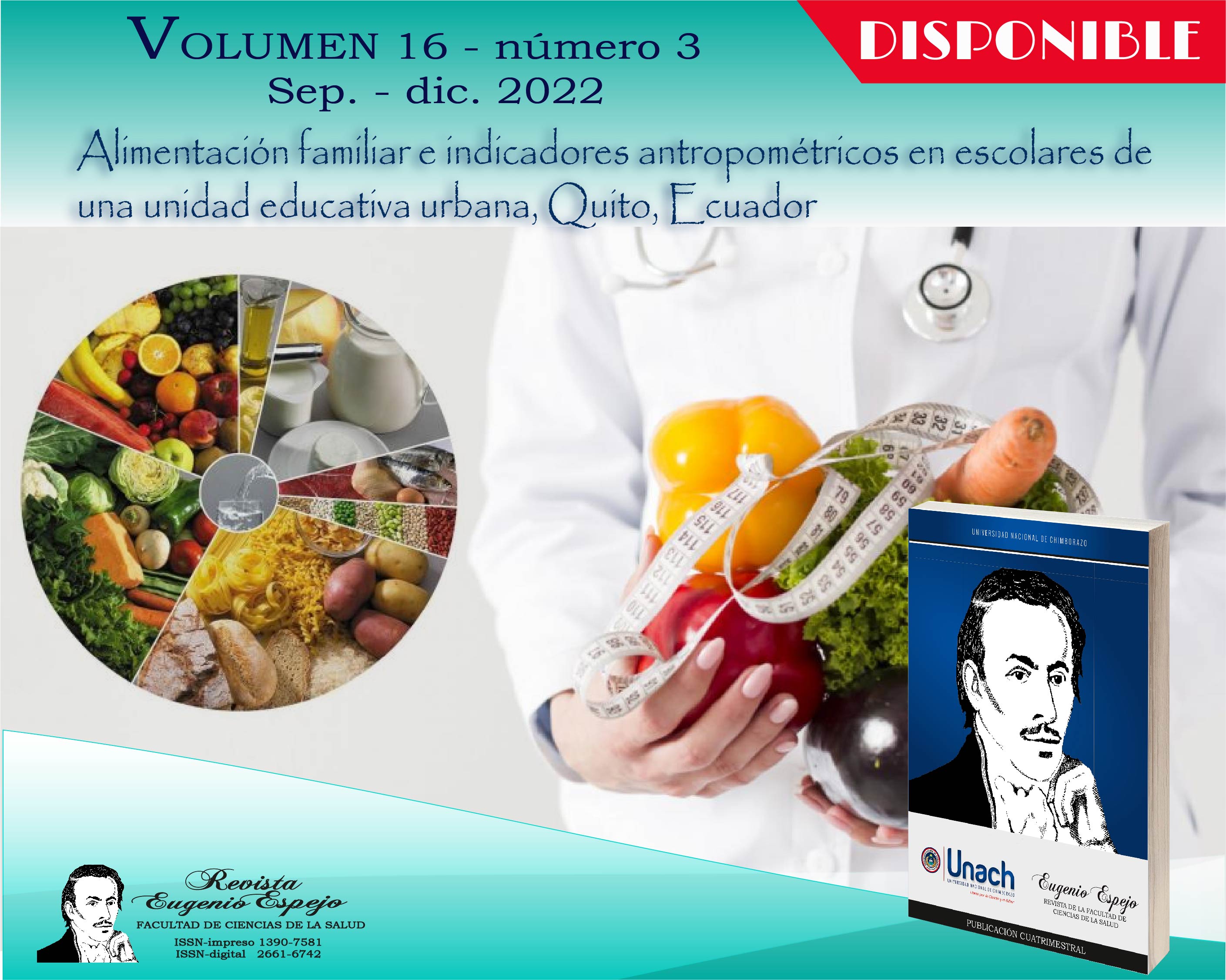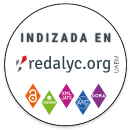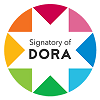Family nutrition and anthropometric indicators in schoolchildren of an urban educational unit, Quito, Ecuador
DOI:
https://doi.org/10.37135/ee.04.15.03Keywords:
Feeding Behavior, Body Mass Index, Parents, ChildAbstract
Child malnutrition is a public health problem. This research aimed to determine the association between the anthropometric indicators of schoolchildren (height, weight, and body mass index) and the nutrition of parents or legal guardians of minors, in an educational institution in the city of Quito, Ecuador, during December 2019. The study had a quantitative and observational, descriptive, and cross-sectional approach, in which 38 schoolchildren aged 5 to 11 years (20 boys and 18 girls) and 32 parents (or legal guardians) participated. 68.75% of the parents required to make changes towards a healthy diet, 68.42% of the children had normal height, 23.68% of the children were at risk of being overweight. The p values of the Kendall Tau C test were greater than 0.05, with no relationship between the variables studied. It was concluded that most of the parents or legal guardians needed to improve the quality of their nutrition. Most of the schoolchildren were overweight or at risk of being overweight, as well as normal size. There was no statistically significant association between the parents' diet and body mass index.
Downloads
References
Instituto Nacional de Estadística y Censos. Encuesta Nacional de Salud y Nutrición [Internet]. Ecuador en cifras. 2018. p. 17–20. Available from: https://www.ecuadorencifras.gob.ec/documentos/web-inec/Estadisticas_Sociales/ENSANUT/ENSANUT_2018/Principales resultados ENSANUT_2018.pdf
World Health Organization. Tenfold increase in childhood and adolescent obesity in four decades: New study by Imperial College London and WHO [Internet]. 2017 [cited 2021 Mar 14]. Available from: https://www.who.int/news/item/11-10-2017-tenfold-increase-in-childhood-and-adolescent-obesity-in-four-decades-new-study-by-imperial-college-london-and-who
World Health Organization. Obesity and overweight [Internet]. World Health Organization. 2021 [cited 2021 Jun 20]. Available from: https://www.who.int/news-room/fact-sheets/detail/obesity-and-overweight
Freire W. Encuesta Nacional de Salud y Nutrición [Internet]. 2014. 2554 p. Available from: http://www.ecuadorencifras.gob.ec/documentos/web-inec/Estadisticas_Sociales/ENSANUT/MSP_ENSANUT-ECU_06-10-2014.pdf
United Nations International Children’s Emergency Fund. Estado Mundial de la Infancia 2019 [Internet]. Nueva York; 2019. 258 p. Available from: https://www.unicef.org/media/62486/file/Estado-mundial-de-la-infancia-2019.pdf
Valencia AL, Berro BT, Jardines IQ. Estado nutricional en niños menores de 5 años en un consultorio de Babahoyo (República del Ecuador). Rev Cubana Hig Epidemiol [Internet]. 2009;47(1):2–10. Available from: http://scielo.sld.cu/scielo.php?script=sci_arttext&pid=S1561-30032009000100003
Brown J, Isaacs JS, Krinke UB, Lechtenberg E, Murtaugh MA, Sharbaugh C, et al. Nutrición en las diferencias etapas de vida. 5a ed. México D.F: McGraw-Hill Interamericana Editores S.A; 2014.
Costa R, Gutiérrez A, Valdivieso D, Carpio L, Cuadrado F, Núñez J, et al. Vigilancia de Enfermedades no Transmisibles y Factores de Riesgo - Informe de resultados encuesta STEPS [Internet]. Ministerio de Salud Pública. 2018. Available from: https://www.salud.gob.ec/wp-content/uploads/2020/10/INFORME-STEPS.pdf
Moreno Villares JM, Collado MC, Larqué E, Leis Trabazo MR, Sáenz de Pipaon M, Moreno Aznar LA. Los primeros mil días: una oportunidad para reducir la carga de las enfermedades no transmisibles. Nutr Hosp [Internet]. 2019;36:218–32. Available from: https://scielo.isciii.es/scielo.php?script=sci_arttext&pid=S0212-16112019000100218
Basain Valdés JM, Valdés Alonso M del C, Álvarez Viltres M, Miyar Pieiga E, Tase Pelegrin TS. Relation of excess weight and central obesity with the duration of exclusive maternal breastfeeding. Rev Cubana Pediatr [Internet]. 2018;90(4). Available from: https://www.medigraphic.com/pdfs/revcubped/cup-2018/cup183g.pdf
Solano-Pinto N, Solbes Canales I, Fernández Cézar R, Calderón López S, Pozo Bardera C. Healthy Habits in Preschoolers and Their Families. An Invitation To Reflection. DEMETRA Aliment Nutr Saúde [Internet]. 2017;12(4):803–22. Available from: https://ruidera.uclm.es/xmlui/bitstream/handle/10578/16231/28657-105960-2-PB_ingles.pdf.pdf?sequence=3&isAllowed=y
Yang W., Burrows T, MacDonald-Wicks L, Williams L., Collins C., Chee S. The Family Diet Study: a cross-sectional study into the associations between diet, food habits and body weight status in Malay families. J Hum Nutr Diet [Internet]. 2016;29(4):441–8. Available from: https://pubmed.ncbi.nlm.nih.gov/26879748/
Ministerio de Salud Pública del Ecuador. Vigilancia de Enfermedades no Transmisibles y Factores de Riesgo - Resumen Ejecutivo encuesta STEPS [Internet]. 2020. Available from: https://www.salud.gob.ec/wp-content/uploads/2020/10/RESUMEN-EJECUTIVO-ENCUESTA-STEPS-final.pdf
Fundación Iberoamericana de Nutrición. No TitleEl índice de calidad de la dieta Healthy Eating Index (HEI) [Internet]. Finut. Ciudad de México; 2018. Available from: https://www.finut.org/indice-calidad-la-dieta-healthy-eating-index-hei/
Norte Navarro AI, Ortiz Moncada R. Calidad de la dieta española según el índice de alimentación saludable. Nutr Hosp [Internet]. 2011;26(2):330–6. Available from: https://scielo.isciii.es/scielo.php?script=sci_arttext&pid=S0212-16112011000200014
Anaya Delgado JF, Ortiz Arias ZA, Rueda Jiménez JM. Factores familiares asociados con los trastornos de alimentación en adolescentes escolarizados [Internet]. Vol. 87, Repositorio de la Universidad de Santander. 2017. Available from: https://repositorio.udes.edu.co/bitstream/001/115/1/Factores familiares asociados con los trastornos de alimentación en adolescentes escolarizados.pdf
López-Morales CM, López-Valenzuela A, González-Heredia R, Brito-Zurita OR, Rosales-Partida E, Palomares-Uribe GH. Family structure of obese/overweight and normal weight adolescents in México. Rev Med Chil [Internet]. 2016;144(2):181–7. Available from: https://www.scielo.cl/scielo.php?script=sci_arttext&pid=S0034-98872016000200006
Gallegos Sarango JC. Hábitos alimentarios, nivel socioeconómico y su relación con el estado nutricional en la población adulta, hombres y mujeres de la Provincia de Loja, Cantón Gonzanamá, Parroquia Nambacola, durante el preriodo agosto 2017 [Internet]. Pontificia Universidad Católica del Ecuador; 2018. Available from: http://repositorio.puce.edu.ec/bitstream/handle/22000/15031/DISERTACIÓN CAROLINA GALLEGOS.pdf?sequence=1&isAllowed=y
Bazan Pérez AE, Camposano Valladares KL. Hábitos alimentarios y estado nutricional en escolares de 9 a 11 años [Internet]. Vol. 39, Revista Cubana de Salud Pública. 2018. Available from: http://repositorio.ual.edu.pe/handle/UAL/101
Sanabria MC, Frutos D, Preda J, Gónzalez Céspedes L, Cornelli P. Adequacy and acceptance of school lunches in two public schools from Asunción. Pediatría (Asunción) [Internet]. 2017;44(2):126–35. Available from: http://scielo.iics.una.py/scielo.php?script=sci_arttext&pid=S1683-98032017000200126&lng=en&nrm=iso&tlng=es
Pandey S, Rai S, Paudel N, Shrestha A, Gautam S. Parental child feeding practices and their relationship with children’s dietary intake and weight status in Nepal. Multidiscip Healthc [Internet]. 2019;12:325–33. Available from: https://www.ncbi.nlm.nih.gov/pmc/articles/PMC6505462/
Yamborisut U, Visetchart P, Thasanasuwan W, Srichan W, Unjana R. Parental feeding practice is associated with child ’s body mass index in Thai school-aged children. Heal Res [Internet]. 2018;32(1):82–94. Available from: https://www.emerald.com/insight/content/doi/10.1108/JHR-11-2017-010/full/html
Warnick JL, Stromberg SE, Krietsch KM, Janicke DM. Family functioning mediates the relationship between child behavior problems and parent feeding practices in youth with overweight or obesity. Soc Behav Med [Internet]. 2019;431–9. Available from: https://academic.oup.com/tbm/article/9/3/431/5489485
Restrepo S, Maya M. La familia y su papel en la formación de los hábitos alimentarios en el escolar. Boletín de antropología americana [Internet]. 2016;(23):67–82. Available from: https://biblat.unam.mx/es/revista/boletin-de-antropologia-americana/articulo/ideologia-identidad-y-cultura-tres-elementos-basicos-en-la-comprension-de-la-reproduccion-cultural
Johnson C., Henderson M., Tripicchio G, Rozin P, Heo M, Pietrobelli A, et al. Observed parent – child feeding dynamics in relation to child body mass index and adiposity. Pediatric Obesity [Internet]. 2017;(11):1–10. Available from: https://onlinelibrary.wiley.com/doi/abs/10.1111/ijpo.12209



















